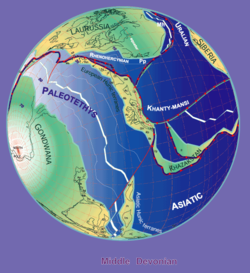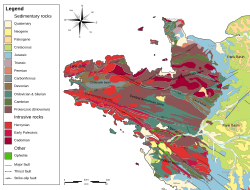

The Armorican terrane, Armorican terrane assemblage, or simply Armorica, was a microcontinent or group of continental fragments that rifted away from Gondwana towards the end of the Silurian and collided with Laurussia towards the end of the Carboniferous during the Variscan orogeny. The name is taken from Armorica, the Gaulish name for a large part of northwestern France that includes Brittany, as this matches closely to the present location of the rock units that form the main part of this terrane.
Extent
The main exposures of the Armorican terrane are found throughout Brittany, the Channel Islands, parts of Upper Normandy, forming the Armorican Massif. Other fragments thought to have originally formed part of the Armorican terrane assemblage include rock units exposed in the Vosges, Black Forest, Bohemian Massif and most of the Iberian peninsula.
History
All of the fragments that make up the Armorican terrane are thought to have originally formed part of the northern margin of Gondwana. Rifting initiated in the Cambrian to Ordovician although the terrane was still close enough to Gondwana to be affected by the Andean-Saharan glaciation during the late Ordovician. Complete separation from Gondwana, across the developing Paleotethys Ocean, is thought to have occurred towards the end of the Silurian. At this time Armorica was separated from Laurussia by the Rheic Ocean. One possible model includes Armorica as part of the Hun superterrane, while other show it moving separately. The Rheic Ocean closed during the Devonian and early Carboniferous, as the oceanic crust was subducted. The Variscan orogeny marks the final closure of the Rheic Ocean as the various continental fragments, including Armorica, collided with Laurussia towards the end of the Carboniferous.
References
- ^ Stampfli, G.M.; von Raumer, J.F.; Borel, J.D. (2002). "Paleozoic evolution of pre-Variscan terranes: From Gondwana to the Variscan collision". In Martínez Catalán, J.R.; Hatcher, R.D. Jr.; Arenas, R.; Díaz García, F. (eds.). Variscan-Appalachian dynamics: The building of the late Paleozoic basement (PDF). Special Paper. Vol. 364. Geological Society of America. pp. 263–280.
- ^ Franke, W. (2000). "The mid-European segment of the Variscides: tectonostratigraphic units, terrane boundaries and plate tectonic evolution". In Franke W.; Haak V.; Oncken O.; Tanner D. (eds.). Orogenic Processes: Quantification and Modelling in the Variscan Belt. Special Publications. Vol. 179. London: Geological Society. pp. 35–61.
- ^ Cocks, L.R.M.; Torsvik, T.H. (2006). "European geography in a global context from the Vendian to the end of the Palaeozoic". In Gee D.G.; Stephenson R.A. (eds.). European Lithosphere Dynamics (PDF). Memoirs. Vol. 32. London: Geological Society. pp. 83–95. Archived from the original (PDF) on 2009-07-31.
- Ziegler, Peter A (1988). Evolution of the arctic-north atlantic and the western Tethys - a visual presentation of a series of paleogeographic-paleotectonic maps. American Association of Petroleum Geologists. ISBN 9780891813200.
